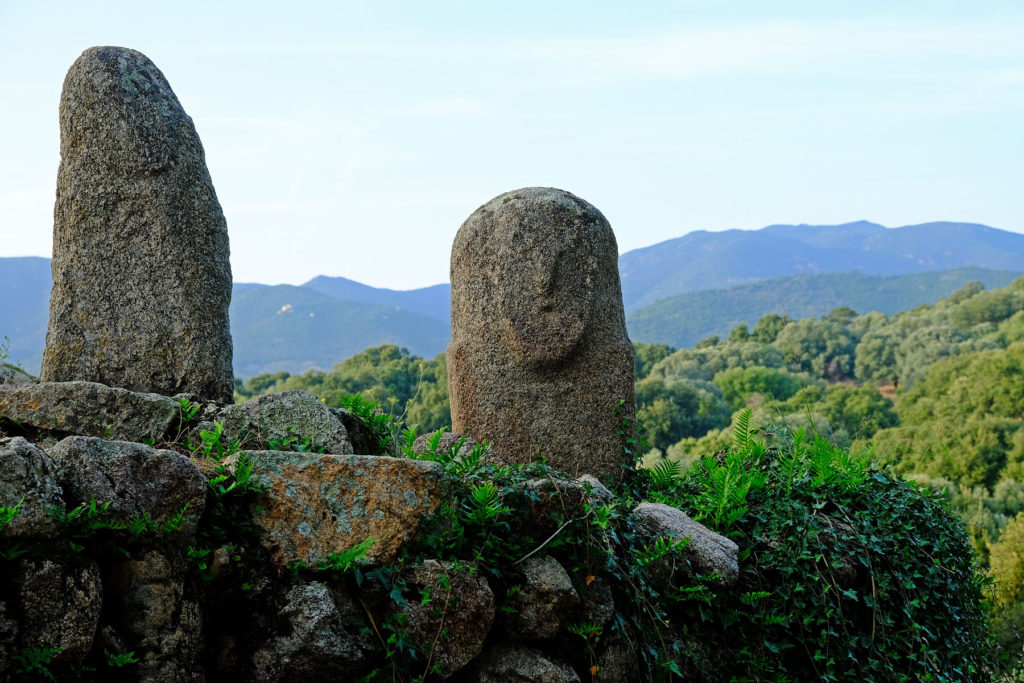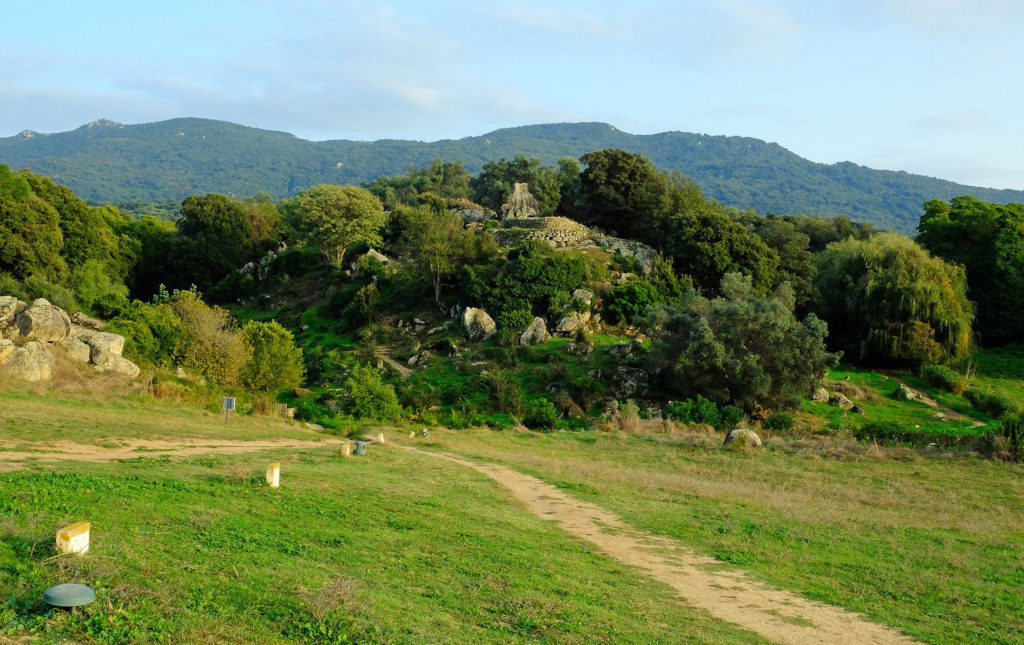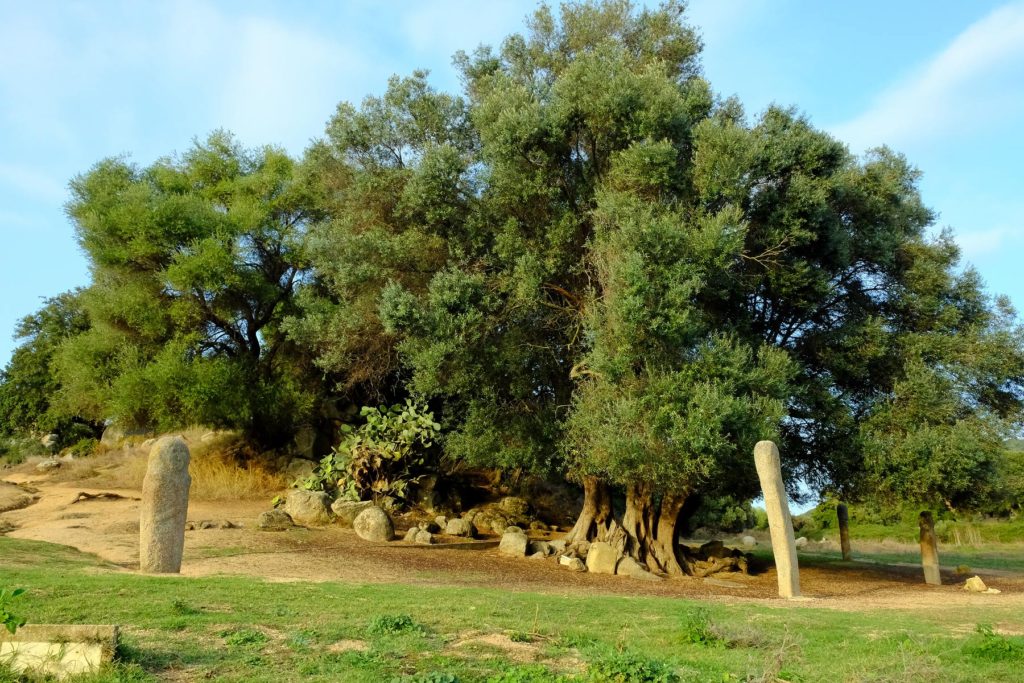
Explore the mysteries of Filitosa, one of the most celebrated megalithic sites in the Mediterranean dating back 8000 years.
Inscribed on the UNESCO World Heritage List the distinctive anthropomorphic sculptures unearthed in 1946 allied to ancient settlement remains and an astonishing collection of prehistoric art unveil the origins of Corsica’s unique heritage.
Set in postcard-worthy scenery of the Taravo Valley the extraordinary array of archaeological treasures is to this day steeped in mystery leaving modern-day historians with many unanswered questions.
This page contains affiliate links meaning I get a commission if you decide to make a purchase through my links, at no extra cost to you. Click here to learn more.

GULF OF VALINCO
The historic site of Filitosa is located in the enchanting Gulf of Valinco, a southernmost bay of Corsica’s west coast stretching from Capo di Muro in the north to the charming village of Campomoro in the south.
This panoramic bay offers a variety of glorious landscapes, from idyllic hidden coves dotting the coast and lush green valleys of Taravo and Rizzanese to silver expanse of olive orchards overlooked by jagged peaks of the Alta Rocca Mountains.
Propriano, a lively passenger port town with a busy marina lined with bars and restaurants is also the principal resort of the gulf.
The seaside villages of Porto-Pollo and Campomoro make perfect destinations for families while the tall granite houses of Olmeto located further inland evoke the village’s turbulent history.
Dominating the Gulf of Valinco is the most ‘Corsican’ of Corsica’s towns- Sartene– a medieval granite fortress oozing with charm.

HISTORY
The remains of monumental complexes and granite menhir statues were discovered in 1946 by Charles-Antoine Cesari within the grounds of his property. In 1954 with the arrival of an archaeologist, Roger Grosjean the excavation works started resulting in the creation of the extraordinary prehistoric center classified as a historic monument in 1998. Over the years the resort has gained recognition with the general public, scientists, and prominent figures worldwide subsequently becoming a hotspot for fascinating insular prehistory.
TIMELINE
- The excavations proved the presence of a Neolithic farming population occupying the Filitosa area in 6000 B.C. Living on hunting, gathering, and fishing the Neolithic people used tools made of rock and wood. The discovery of the unavailable in Corsica obsidian used to make arrowheads indicated that the local population must have imported the volcanic rock from Sardinia.
- In the Middle and Late Neolithic period (4900-3100 BC.) the size of the local Corsican population increased due to the development of agricultural practices. With the colonization of the Megalithic people from the East, the first menhirs were created. Distinct from other large stone monuments in Europe, the statues could have been erected as phallic symbols by a fertility cult or later as memorials to deceased warriors. Roger Grosjean believed the statue-menhirs represent armed with swords Sherden warriors, the enemy Torréens who invaded Corsica from the Eastern Mediterranean.
- Metalwork improvements of the Bronze Age (2200-850 B.C.) brought dynamic changes to the area. The Torréens who conquered Filitosa around 1300 B.C. used previously destroyed fragments of the menhir-statue stones in constructing walls surrounding the
casteddi – a village complex with its threetorri overlooking the houses. The function of the towers is not clear although they are thought to have served either as places of worship or burial celebrations points reflected by the presence of ashes. The largertorri were used as stores for food supplies or weapons.
VISIT FILITOSA FROM AJACCIO WITH A PRIVATE DRIVER
- Cruise ship passengers and other visitors looking to enjoy their custom day itinerary around Ajaccio and the surrounding regions may hire a driver or even upgrade to include a private tour guide. Guests are welcome to choose their preferred time and place of departure. Private tours last for up to 8 hours and are also offered in English. Click here to learn more and make an early reservation.

EXPLORE THE SITE OF FILITOSA
- Filitosa V, Corsica’s largest statue-menhir with carved facial features and a sword is the first monument after the entrance.
- Eastern Monument where the remains of a torri may be found is located after a left turn further along the path. Cave-shaped rocks at its entrance give testimony to a Neolithic occupation of the site.
- Central Monument situated further ahead at Oppidum comprises of a group of menhirs gathered on a circular mound.
- The statue of Filitosa IX is considered the finest example of Corsican megalithic art while the nearby Filitosa XIII, the last menhir to be found, had been built into the base of the Central Monument.
- Filitosa VI with exquisite facial features is placed behind the Central Monument. Its three parts are displayed side by side on a rock.
- Further down on the eastern side of the Central Monument where the Torréen houses are situated some of the most ancient fragments of ceramics were found. Visitors may admire the artifacts displayed in the museum.
- The remains of the third torri, a three-roomed religious building- are positioned at the Western Monument. Beyond a small bridge, another highlight of Filitosa may be found- a semi-circle of statues gathered beneath an ancient olive tree. A little further up the hill, a stone quarry where the menhirs were extracted is situated.
- A fascinating collection of further menhirs and ancient artifacts may be seen in an environmentally integrated archaeological museum complex at the end of the visit circuit.
VISIT FILITOSA FROM AJACCIO WITH A PRIVATE DRIVER
- Cruise ship passengers and other visitors looking to enjoy their custom day itinerary around Ajaccio and the surrounding regions may hire a driver or even upgrade to include a private tour guide. Guests are welcome to choose their preferred time and place of departure. Private tours last for up to 8 hours and are also offered in English. Click here to learn more and make an early reservation.

PRACTICAL INFORMATION
- The site is situated on D57 near Sollacaro in the heart of the Taravo Valley, around 20km north of the resort of Propriano.
- No public transport services Filitosa although the Propriano-Porto Pollo bus stops at the D157/D57 junction, around 7 km away from the site.
- There is a small free car park in front of the site’s entrance.
- Filitosa is open to the public from the beginning of April to the end of October. It may be possible to visit the site outside the visiting period if you phone in advance.
- The standard fare is €9 although discounts are available for groups and people with physical disabilities. Children under 6 are free of charge. A family ticket (2 adults and 2 children) costs €28.
- A full visit takes approximately one hour and the route is marked with numerous signposts in various languages.
- The eerie atmosphere of the complex is best experienced early in the morning or late in the day when mysterious statues are lit by the golden rays of the setting sun.
- Eating, smoking, and touching the megaliths within the grounds are forbidden, however, you may bring your pet on a lead.
- In the hot summer
months, hats and sunglasses are recommended. - There is a bar/restaurant at the site where you may purchase refreshments.
- For more information check the user-friendly official website www.filitosa.fr
Find other family-friendly activities and attractions in Corsica.
HELPFUL TRAVEL RESOURCES :
Please help support CoolCorsica!
If you find this website as useful as a guidebook you may have had to buy to plan your adventures, please consider helping me with a small donation.
This all-content traveler-focused site is created in my spare time with a desire to share comprehensive information, useful tips, and inspiring photos of Corsica’s most scenic locations.
Please note that certain products/services and links to products/services are affiliate links and I may earn a commission for any purchases that you make, at no additional cost to you. I truly appreciate your use of any of the links I share.
With your generous help, I can continue to offer my advice and support in planning your dream holiday.
Thank you for your contribution!
